charging MERCEDES-BENZ R-CLASS FAMILY TOURER 2013 Owners Manual
[x] Cancel search | Manufacturer: MERCEDES-BENZ, Model Year: 2013, Model line: R-CLASS FAMILY TOURER, Model: MERCEDES-BENZ R-CLASS FAMILY TOURER 2013Pages: 364, PDF Size: 28.68 MB
Page 8 of 364
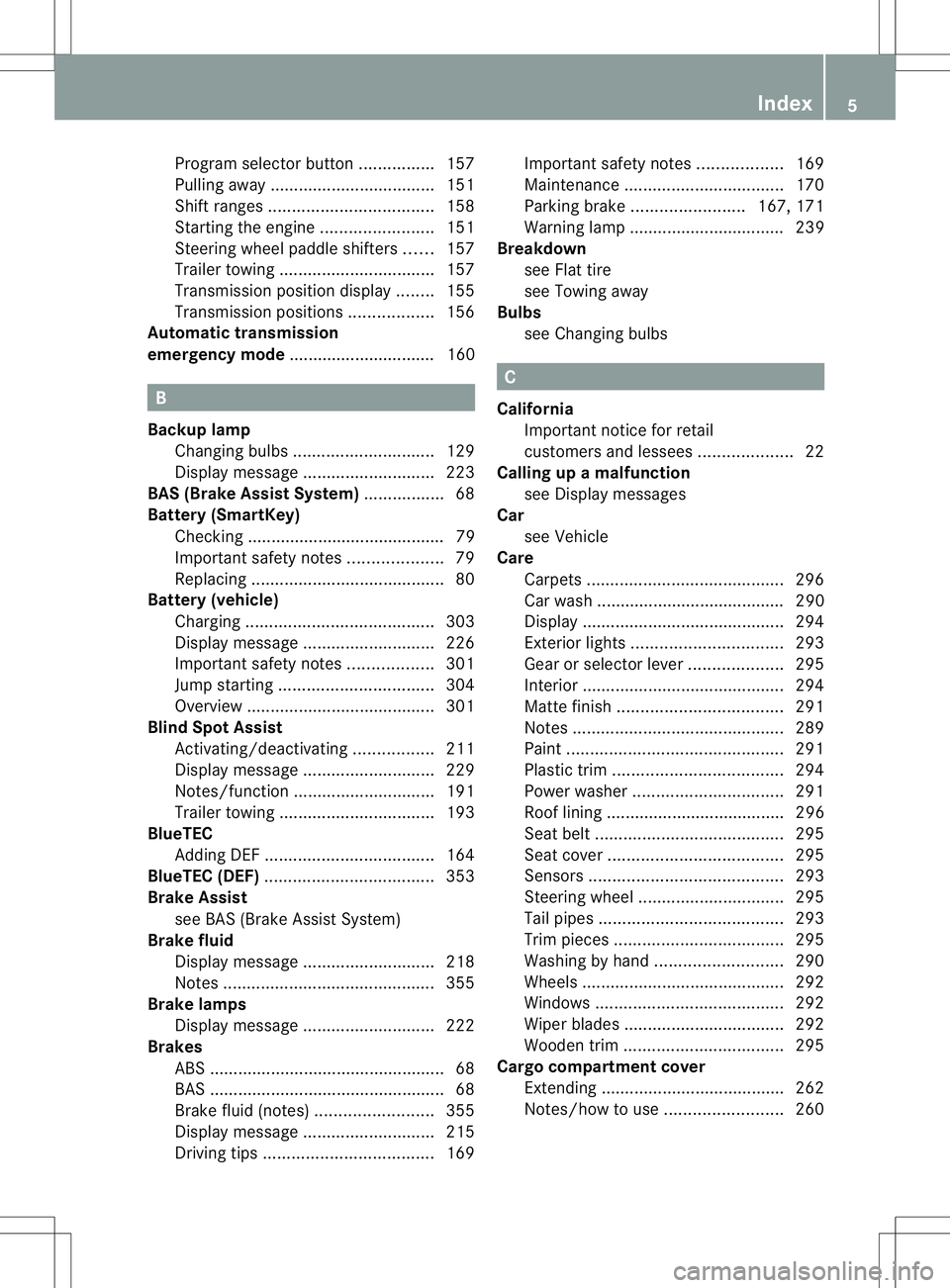
Program selector button
................157
Pulling away ................................... 151
Shift range s................................... 158
Starting the engine ........................151
Steering wheel paddle shifters ......157
Trailer towing ................................. 157
Transmissio nposition display ........155
Transmission positions ..................156
Automatic transmission
emergency mode ............................... 160 B
Backup lamp Changing bulbs .............................. 129
Display message ............................ 223
BAS (Brake Assist System) .................68
Battery (SmartKey) Checking .......................................... 79
Important safety notes ....................79
Replacing ......................................... 80
Battery (vehicle)
Charging ........................................ 303
Display message ............................ 226
Important safety notes ..................301
Jump starting ................................. 304
Overview ........................................ 301
Blin dSpot Assist
Activating/deactivating .................211
Display message ............................ 229
Notes/function .............................. 191
Trailer towing ................................. 193
BlueTEC
Adding DEF .................................... 164
BlueTEC (DEF) .................................... 353
Brake Assist see BAS (Brake Assist System)
Brake fluid
Display message ............................ 218
Notes ............................................. 355
Brake lamps
Display message ............................ 222
Brakes
ABS .................................................. 68
BAS .................................................. 68
Brake fluid (notes) .........................355
Display message ............................ 215
Driving tips .................................... 169Important safety notes
..................169
Maintenance .................................. 170
Parking brake ........................ 167, 171
Warning lamp ................................. 239
Breakdown
see Flat tire
see Towing away
Bulbs
see Changing bulbs C
California Important notice for retail
customers and lessees ....................22
Calling up a malfunction
see Display messages
Car
see Vehicle
Care
Carpets .......................................... 296
Car wash ........................................ 290
Display ........................................... 294
Exterior lights ................................ 293
Gea rors electo rlever .................... 295
Interior ........................................... 294
Matte finish ................................... 291
Notes ............................................. 289
Paint .............................................. 291
Plastic trim .................................... 294
Power washer ................................ 291
Roof lining ...................................... 296
Seat bel t........................................ 295
Seat cover ..................................... 295
Sensors ......................................... 293
Steering wheel ............................... 295
Tai lpipes ....................................... 293
Trim pieces .................................... 295
Washing by hand ........................... 290
Wheels ........................................... 292
Windows ........................................ 292
Wiper blades .................................. 292
Wooden trim .................................. 295
Cargo compartment cover
Extending ...................................... .262
Notes/ho wtouse......................... 260 Index
5
Page 123 of 364
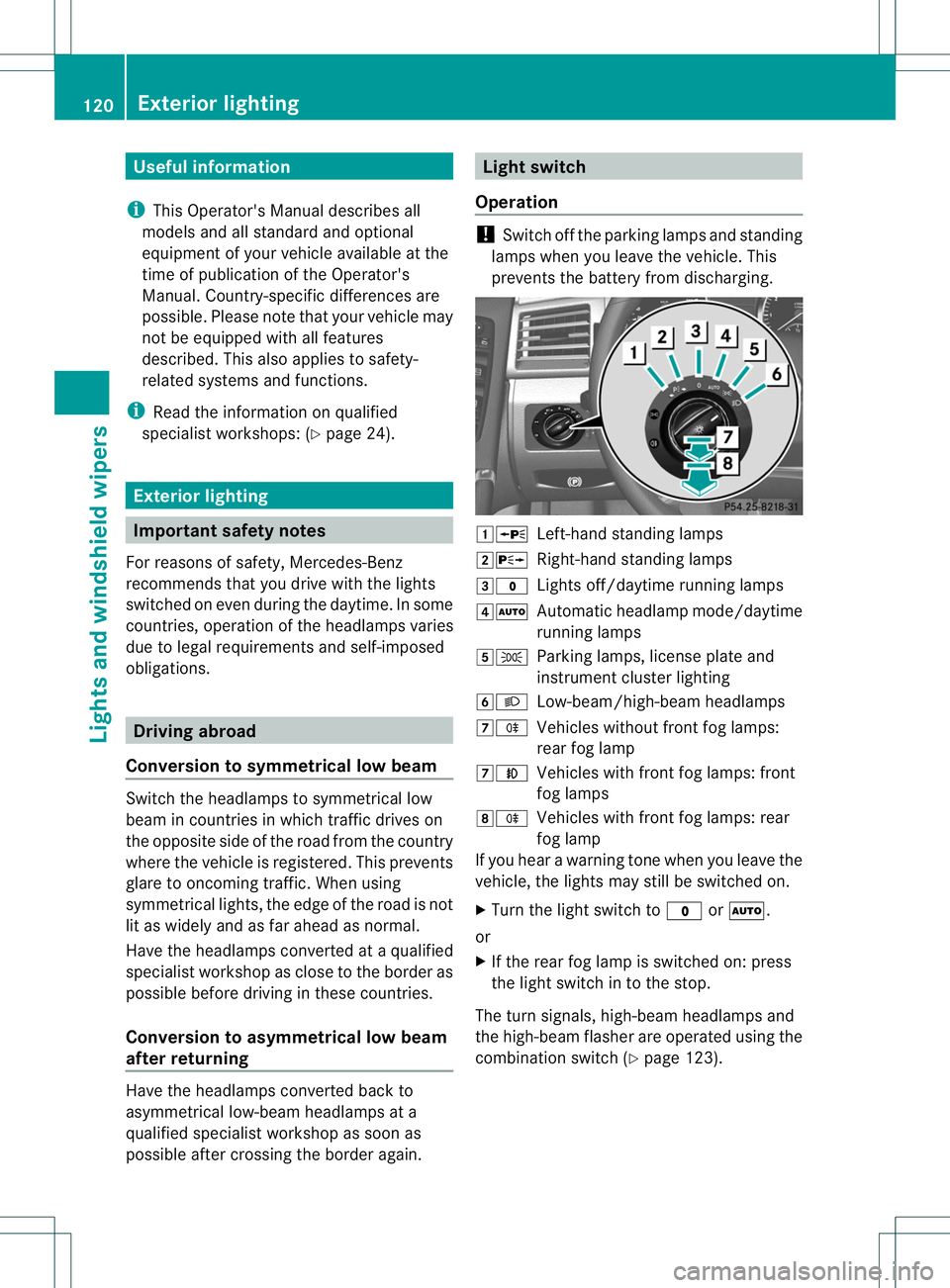
Useful information
i This Operator's Manual describes all
models and all standard and optional
equipment of your vehicle available at the
time of publication of the Operator's
Manual. Country-specific differences are
possible. Please note that your vehicle may
not be equipped with all features
described. This also applies to safety-
related systems and functions.
i Read the information on qualified
specialist workshops: (Y page 24).Exterior lighting
Important safety notes
For reasons of safety, Mercedes-Benz
recommends that you drive with the lights
switched on even during the daytime. In some
countries, operation of the headlamps varies
due to legal requirements and self-imposed
obligations. Driving abroad
Conversion to symmetrical low beam Switch the headlamps to symmetrical low
beam in countries in which traffic drives on
the opposite side of the road from the country
where the vehicle is registered. This prevents
glare to oncoming traffic. When using
symmetrical lights, the edge of the road is not
lit as widely and as far ahead as normal.
Have the headlamps converted at a qualified
specialist workshop as close to the border as
possible before driving in these countries.
Conversion to asymmetrical low beam
after returning
Have the headlamps converted back to
asymmetrical low-beam headlamps at a
qualified specialist workshop as soon as
possible after crossing the border again. Light switch
Operation !
Switch off the parking lamps and standing
lamps when you leave the vehicle. This
prevents the battery from discharging. 1W
Left-hand standing lamps
2X Right-hand standing lamps
3$ Lights off/daytime running lamps
4Ã Automatic headlamp mode/daytime
running lamps
5T Parking lamps, license plate and
instrumen tcluste rlighting
6L Low-beam/high-beam headlamps
7R Vehicles without front fog lamps:
rear fog lamp
7N Vehicles with front fog lamps: front
fog lamps
8R Vehicles with front fog lamps: rear
fog lamp
If you hear a warning tone when you leave the
vehicle, the lights may still be switched on.
X Turn the light switch to $orÃ.
or
X If the rear fog lamp is switched on: press
the light switch in to the stop.
The tur nsignals, high-beam headlamps and
the high-beam flasher are operated using the
combination switch (Y page 123).120
Exterior lightingLights and windshield wipers
Page 128 of 364
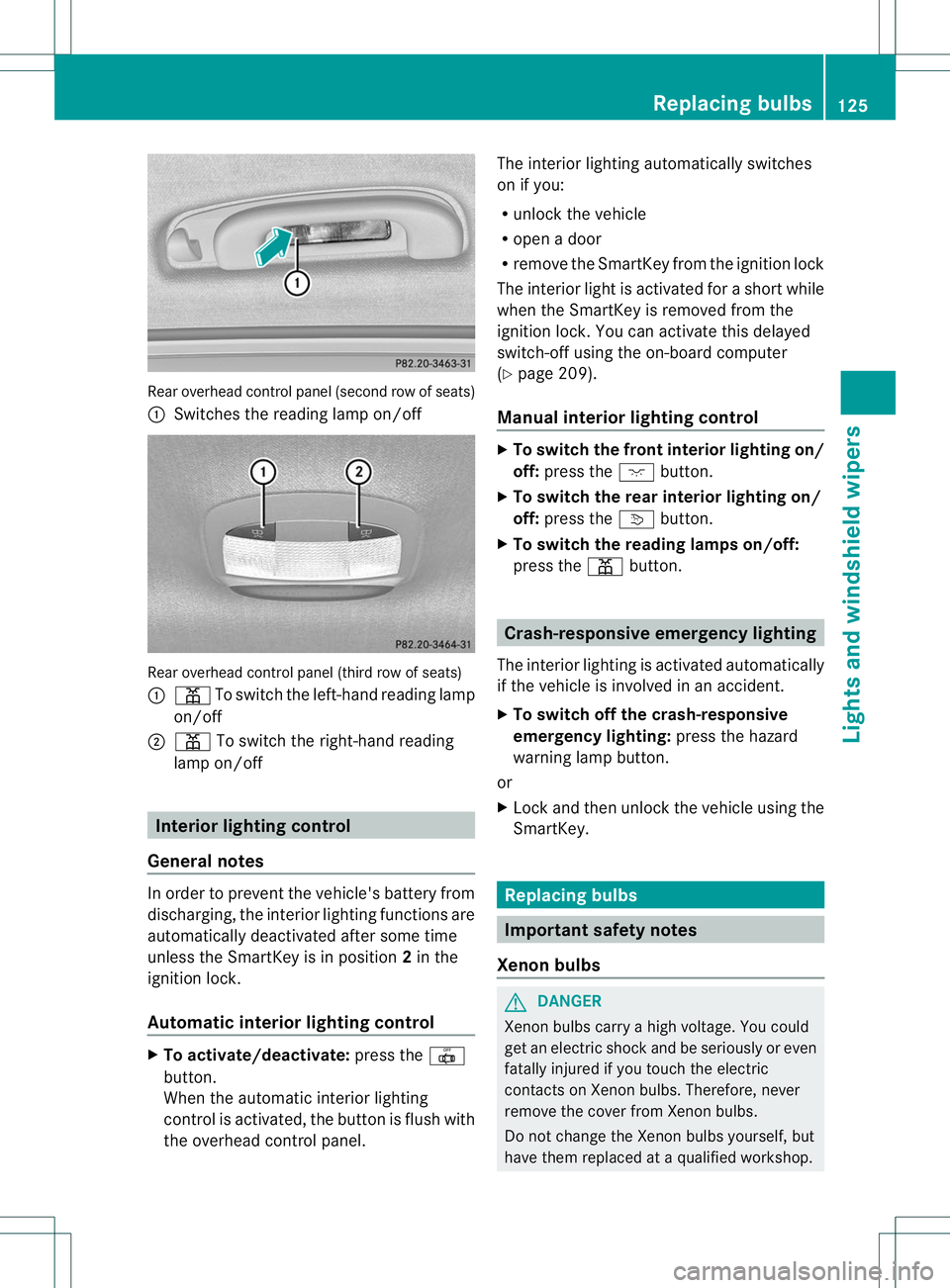
Rear overhead control panel (second row of seats)
:
Switches the reading lamp on/off Rear overhead control panel (third row of seats)
:
p To switch the left-hand reading lamp
on/off
; p To switch the right-han dreading
lamp on/off Interior lighting control
General notes In order to preven
tthe vehicle's battery from
discharging, the interior lighting functions are
automatically deactivated after some time
unless the SmartKey is in position 2in the
ignition lock.
Automatic interior lighting control X
To activate/deactivate: press the|
button.
When the automatic interior lighting
control is activated, the button is flush with
the overhead control panel. The interior lighting automatically switches
on if you:
R
unlock the vehicle
R open a door
R remove the SmartKey from the ignition lock
The interior light is activated for a short while
when the SmartKey is removed from the
ignition lock. You can activate this delayed
switch-off using the on-board computer
(Y page 209).
Manual interior lighting control X
To switch the front interior lighting on/
off: press the cbutton.
X To switch the rear interior lighting on/
off: press the vbutton.
X To switch the reading lamps on/off:
press the pbutton. Crash-responsive emergency lighting
The interior lighting is activated automatically
if the vehicle is involved in an accident.
X To switch off the crash-responsive
emergency lighting: press the hazard
warning lamp button.
or
X Lock and then unlock the vehicle using the
SmartKey. Replacing bulbs
Important safety notes
Xenon bulbs G
DANGER
Xenon bulbs carry a high voltage. You could
get an electric shock and be seriously or even
fatally injured if you touch the electric
contacts on Xenon bulbs. Therefore, never
remove the cover from Xenon bulbs.
Do not change the Xenon bulbs yourself, but
have them replaced at a qualified workshop. Replacing bulbs
125Lights and windshield wipers Z
Page 171 of 364
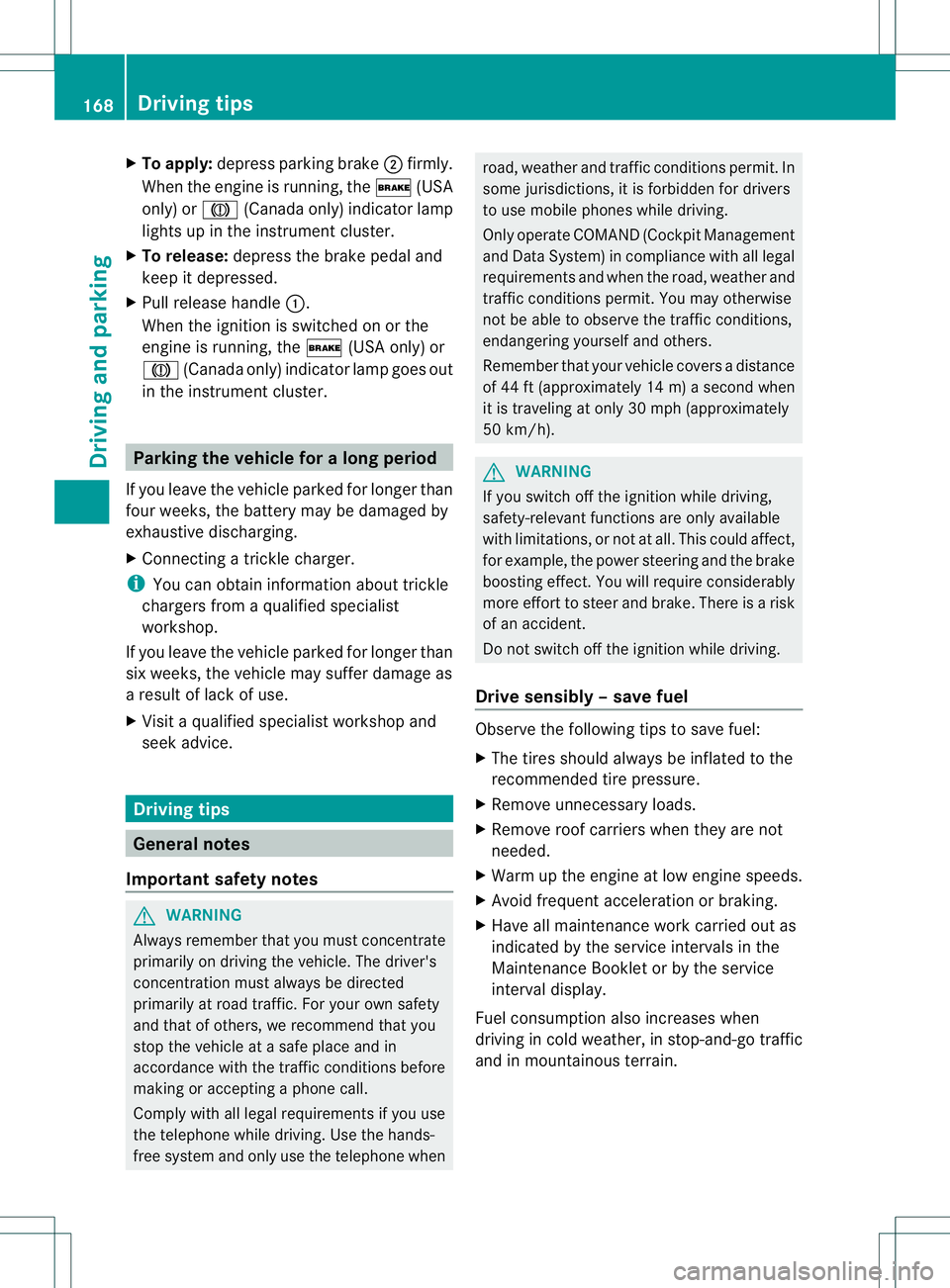
X
To apply: depress parking brake ;firmly.
Whe nthe engine is running, the $(USA
only) or J(Canada only) indicator lamp
lights up in the instrumentc luster.
X To release: depress the brake pedal and
keep it depressed.
X Pull release handle :.
When the ignition is switched on or the
engine is running, the $(USA only) or
J (Canada only) indicator lamp goes out
in the instrument cluster. Parking the vehicle for
along period
If you leave the vehicle parked for longer than
four weeks, the battery may be damaged by
exhaustive discharging.
X Connecting a trickle charger.
i You can obtain information about trickle
chargers from a qualified specialist
workshop.
If you leave the vehicle parked for longer than
six weeks, the vehicle may suffer damage as
a result of lack of use.
X Visit a qualified specialist workshop and
seek advice. Driving tips
General notes
Important safety notes G
WARNING
Always remembe rthat you must concentrate
primarily on driving the vehicle. The driver's
concentration must always be directed
primarily at road traffic. For your own safety
and that of others, we recommend that you
stop the vehicle at a safe place and in
accordance with the traffic conditions before
making or accepting a phone call.
Comply with all legal requirements if you use
the telephone while driving. Use the hands-
free system and only use the telephone when road, weather and traffic conditions permit. In
some jurisdictions, it is forbidden for drivers
to use mobile phones while driving.
Only operate COMAND (Cockpit Management
and Data System) in compliance with all legal
requirements and when the road, weather and
traffic conditions permit. You may otherwise
not be able to observe the traffic conditions,
endangering yourself and others.
Remember that your vehicle covers a distance
of 44 ft (approximately 14
m)a second when
it is traveling at only 30 mph (approximately
50 km/h). G
WARNING
If you switch off the ignition while driving,
safety-relevan tfunctions are only available
with limitations, or no tatall. This could affect,
for example, the power steering and the brake
boosting effect .You will require considerably
more effort to steer and brake. There is a risk
of an accident.
Do not switch off the ignition while driving.
Drive sensibly –save fuel Observe the following tips to save fuel:
X
The tires should always be inflated to the
recommended tire pressure.
X Remove unnecessary loads.
X Remove roof carriers whe nthey are not
needed.
X Warm up the engine at low engine speeds.
X Avoid frequent acceleration or braking.
X Have all maintenance work carried out as
indicated by the service intervals in the
Maintenance Booklet or by the service
interval display.
Fuel consumption also increases when
driving in cold weather, in stop-and-go traffic
and in mountainous terrain. 168
Driving tipsDriving and parking
Page 306 of 364
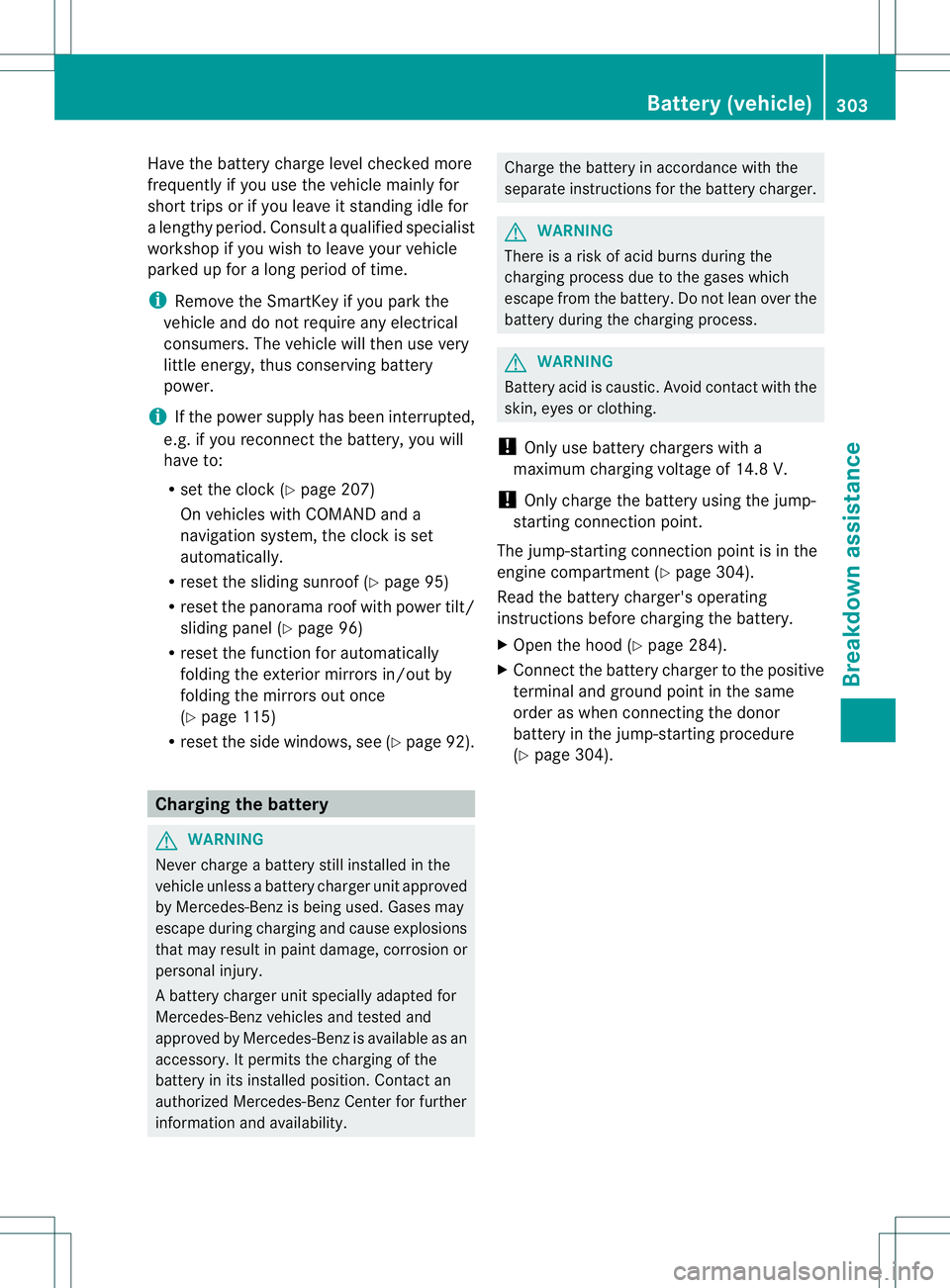
Have the battery charge level checked more
frequently if you use the vehicle mainly for
shor
ttrips or if you leave it standing idle for
a lengthy period. Consult a qualified specialist
workshop if you wish to leave yourv ehicle
parked up for a long period of time.
i Remove the SmartKey if you park the
vehicle and do not require any electrical
consumers. The vehicle will then use very
little energy, thus conserving battery
power.
i If the power supply has been interrupted,
e.g. if you reconnectt he battery, you will
have to:
R set the clock (Y page 207)
On vehicles with COMAND and a
navigation system, the clock is set
automatically.
R reset the sliding sunroof (Y page 95)
R reset the panorama roof with power tilt/
sliding panel (Y page 96)
R reset the function for automatically
folding the exterior mirrors in/out by
folding the mirrors out once
(Y page 115)
R reset the side windows, see (Y page 92).Charging the battery
G
WARNING
Never charge a battery still installed in the
vehicle unless a battery charger unit approved
by Mercedes-Ben zis being used. Gases may
escape during charging and cause explosions
that may result in paint damage, corrosion or
personal injury.
Ab attery charge runit specially adapted for
Mercedes-Benz vehicles and tested and
approved by Mercedes-Benz is available as an
accessory. It permits the charging of the
battery in its installed position. Contact an
authorized Mercedes-Benz Center for further
informatio nand availability. Charge the battery in accordance with the
separate instructions for the battery charger.
G
WARNING
There is a ris kofacid burns during the
charging process due to the gases which
escape from the battery .Do not lean over the
battery during the charging process. G
WARNING
Battery acid is caustic. Avoid contact with the
skin, eyes or clothing.
! Only use battery chargers with a
maximum charging voltage of 14.8 V.
! Only charge the battery using the jump-
starting connection point.
The jump-starting connection point is in the
engine compartment (Y page 304).
Read the battery charger's operating
instructions before charging the battery.
X Open the hood (Y page 284).
X Connect the battery charger to the positive
terminal and ground point in the same
order as when connecting the donor
battery in the jump-starting procedure
(Y page 304). Battery (vehicle)
303Breakdown assistance Z
Page 307 of 364
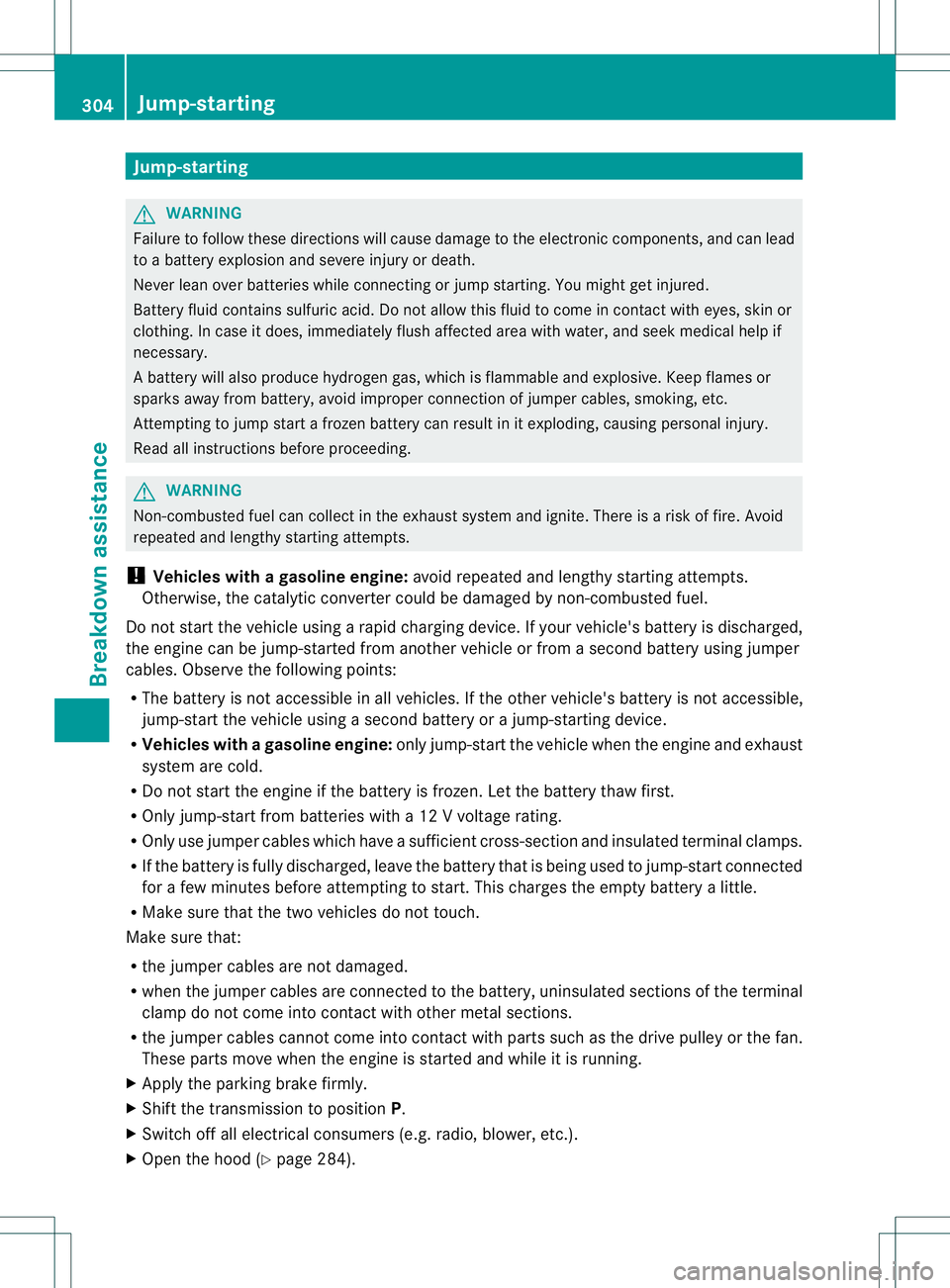
Jump-starting
G
WARNING
Failure to follow these directions will cause damage to the electronic components, and can lead
to a battery explosion and severe injury or death.
Never lean over batteries while connecting or jump starting. You might get injured.
Battery fluid contains sulfuric acid. Do not allow this fluid to come in contact with eyes, skin or
clothing. In case it does, immediately flush affected area with water, and seek medical help if
necessary.
Ab attery will also produce hydrogen gas, which is flammable and explosive. Keep flames or
sparks away from battery, avoid improper connectionofj umpercables, smoking, etc.
Attempting to jump start a frozen battery can result in it exploding, causing personal injury.
Read all instructions before proceeding. G
WARNING
Non-combusted fuel can collect in the exhaust system and ignite. There is a risk of fire. Avoid
repeated and lengthy starting attempts.
! Vehicles with agasoline engine: avoid repeated and lengthy starting attempts.
Otherwise, the catalytic converter could be damaged by non-combusted fuel.
Do not start the vehicle using a rapid charging device. If yourv ehicle's battery is discharged,
the engine can be jump-started from another vehicle or from a second battery using jumper
cables. Observe the following points:
R The battery is not accessible in all vehicles. If the other vehicle's batter yis not accessible,
jump-start the vehicle using a second battery or ajump-starting device.
R Vehicles with agasoline engine: only jump-start the vehicle whent he engine and exhaust
system are cold.
R Do not start the engine if the battery is frozen. Let the battery thaw first.
R Only jump-start from batteries with a 12 V voltage rating.
R Only use jumper cables which have a sufficient cross-section and insulated terminal clamps.
R If the battery is fully discharged, leave the battery that is being used to jump-start connected
for a few minutes before attempting to start. This charges the empty battery a little.
R Make sure that the two vehicles do not touch.
Make sure that:
R the jumper cables are not damaged.
R when the jumper cables are connected to the battery, uninsulated sections of the terminal
clamp do not come into contact with other metal sections.
R the jumper cables cannot come into contact with parts such as the drive pulley or the fan.
These parts move when the engine is started and while it is running.
X Apply the parking brake firmly.
X Shift the transmission to position P.
X Switch off all electrical consumers (e.g. radio, blower, etc.).
X Open the hood (Y page 284).304
Jump-startingBreakdown assistance